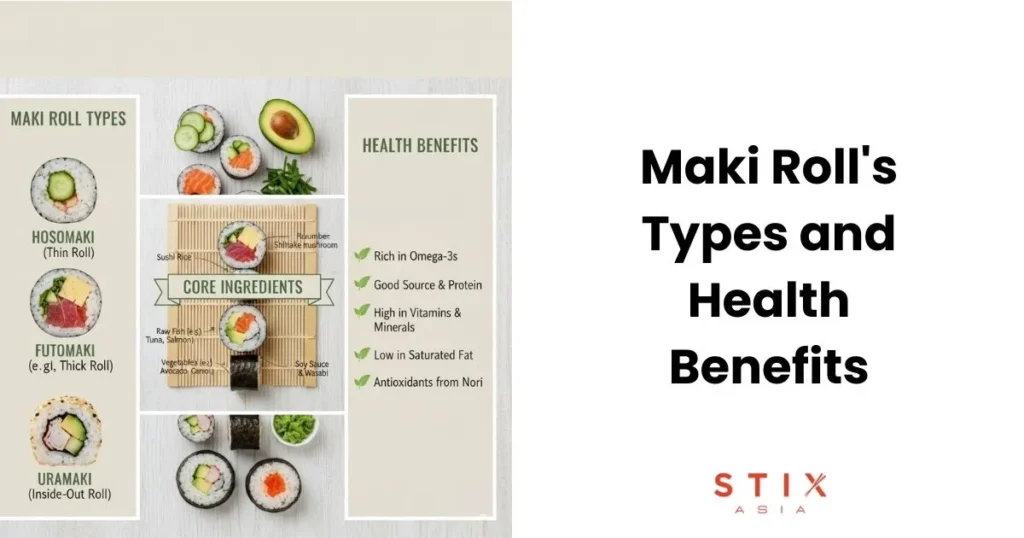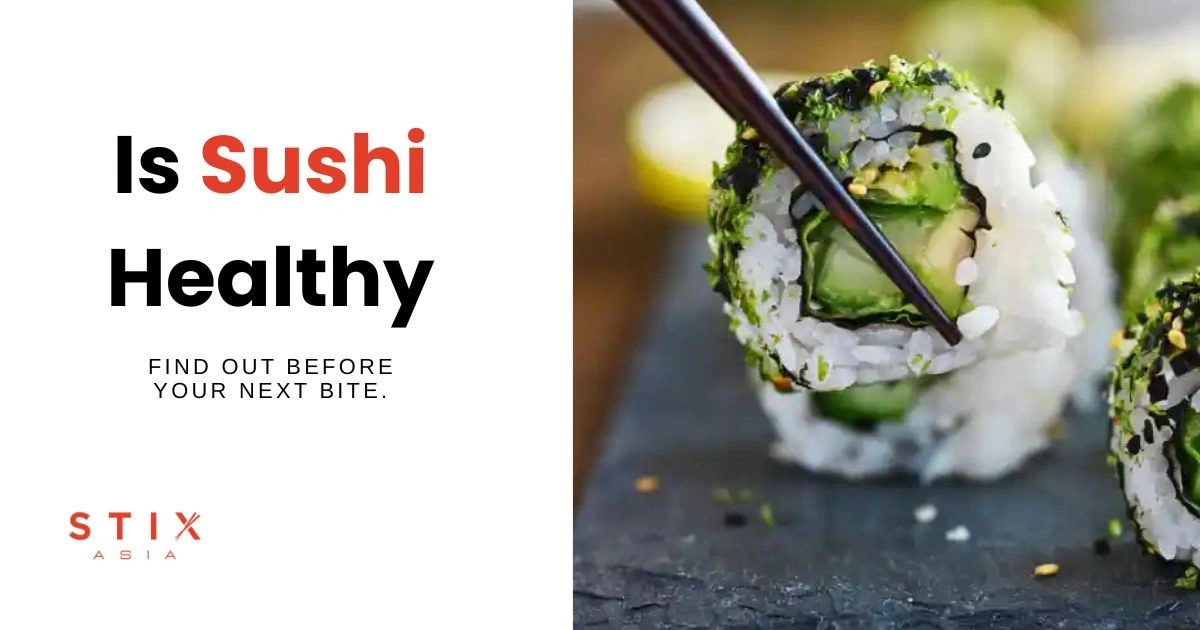By the end of this blog, you’ll know exactly how to enjoy sushi with traditional or modern accompaniments.
What’s Maki?
In the sushi world, maki is a classic sushi roll. Vinegared rice and fillings are wrapped in a nori sheet and cut into bite-sized pieces. It’s versatile and caters to everyone. You can add seafood, veggies, and even fruits as fillings, according to your taste palate. This is why even first-time sushi eaters like it.
Maki Meaning and Origin:
In Japanese, the word Maki is derived from the verb “maku”, which means “rolling” or “wrapping”.
The full term Makizushi, used for maki sushi, literally means “rolled sushi”.
This style originated in the Edo period of Japan, where chefs combined vinegared rice, seaweed, and fillings in tasty bite-sized pieces.
What Does Maki Taste Like?
The taste of Maki is slightly savory and salty because of the vinegared rice and nori wrapping. Fillings like cucumber provide crunch, and seafood provides the original flavour. Overall, every bite offers a rich and balanced taste.
Ingredients of Maki:
As you know, every sushi has some basic essential ingredients with some optional or variable ingredients; the same is true for maki. The essential ingredients are:
Essential Maki Ingredients:
- Sushi Rice (Shari): Made from vinegared rice, sugar, and salt is a mandatory part of any sushi.
- Nori Seaweed and Alternatives: Nori seaweed is the traditional component that adds the salty touch. The modern alternatives are soy paper or omelet wrap.
- Fish: Tuna, salmon, shrimp, or carbs.
- Veggies: Cucumber, carrots, or avocados.
Popular Options:
- Cooked or Cured Varieties: such as cooked chicken, shrimp tempura, or grilled eel.
- Cream Cheese: Such as in Philadelphia rolls.
-
- Mayonnaise: for cream, texture, and taste.
- Tropical Fruits: such as mangoes or pineapple.
Traditional Accompaniments of Maki:
Maki is usually served with traditional sides that increase the taste and freshness, such as pickled gingers, wasabi sauce, soy sauce dipping, miso soup, or last but not least green tea for a warm and balanced dining experience.
How is Maki Made?
Making maki is a matter of precision and creativity. Here’s the simple procedure:
-
Prepare the Ingredients:
Season the rice and cook it, prepare the fillings ( fish, veggies, nori, sauces, etc.)
-
Lay Down the Nori:
Keep the shiny side down on the bamboo mat.
-
Spread the Rice:
Spread evenly on the nori, leaving the top border.
-
Add Fillings:
Add sauces, fish, veggies, or tempura in the horizontal line.
-
Roll it Up:
Lift the mat and roll the fillings tightly.
-
Cut into Pieces:
With the help of a sharp, damp knife, cut into bite-sized pieces.
Types of Maki:
Ever stared at the sushi menu, wondering why rolls come in so many types and sizes? Don’t worry, we got you. Maki sushi has brilliantly evolved with time, offering something for everyone. Here are some popular types that can help you understand which maki sushi you should try next:

Hosomaki/ Thin Rolls:
Hosomaki reflects simplicity. They are small, thin, one-filling rolls. Usually, wrapped in nori with rice and one basic ingredient, tuna or cucumber (depending on your choice). If you prefer clean, focused flavours, this is the best option.
Futomaki/ Thick Rolls:
As the name reflects, futomaki are thick, hearty rolls with multiple fillings such as egg, cucumber, sushi rice, and veggies. They’re vibrant and colorful, best for people who like a bold and satisfying bite in each roll.
Uramaki/ Inside-out Rolls:
Uramaki is the game changer, it flips the tradition, keeping the rice outside and the nori wrap and the fillings inside. These rolls are generally topped with sesame seeds or roe. Some famous examples include California rolls and rainbow rolls. This modern flavor makes uramaki roll types a favorite for sushi beginners.
Temaki / Handrolls:
Temaki are cone-shaped, hand-made rolls. They are not sliced into pieces. They are filled with generous portions of rice, fish, and veggies, wrapped in nori rolls.
Ehomaki/ Lucky Rolls:
Ehomaki are special, thick rolls traditionally eaten during Japan’s Setsubun festival for good fortune. They’re not sliced; instead, you eat them whole while facing a “lucky direction.” Each roll includes seven ingredients symbolizing happiness and prosperity.
Chumaki/ Medium Rolls:
Chumaki sits right between hosomaki and futomaki in size. They balance flavor variety with neatness, often containing two to three fillings. If you like a satisfying roll without being overwhelmed, chumaki is your sweet spot.
Kanpyo Maki:
This is the go-to maki sushi roll for vegans, made from gourd strips, simmered in soy sauce. It has a little chewy, savory taste and offers an umami depth when paired with pickled gingers or wasabi.
Kappa Maki:
Kappa maki is made from crispy cucumbers. It’s light, hydrating, and crunchy. A must-try for people who like light, earthy flavour.
Shinko Maki:
Made from pickled radish. It offers a bright, crunchy, and tangy flavor in the sushi platter.
Natto Maki:
These rolls are made from fermented soybeans, also known as natto. They give a sticky texture and a strong aroma. They are known for probiotics and their beloved taste in Japan, best for health-conscious sushi fans.
Tekka Maki:
Teka maki is a sushi classic, made from ruby-red tuna wrapped in nori and rice. It’s really delicious, especially for those who want to experience the fresh oceanic taste of raw fish.
Nakamaki:
Naka means middle. In Nakamaki, various ingredients are placed in the middle, balancing flavor and texture. These rolls are best for people who like a moderate taste between plain and bold.
Maki vs Other Sushi Types:

Maki vs Sushi:
Sushi is a broader category of vinegared rice, and maki rolls are a type of it.
Maki vs Nigiri:
- Maki is in roll form, made from rice, filling, and nori wrap.
- Nigiri is made from a rice mound with a fish on top. Simple and minimalist.
- Nigiri highlights fish, whereas maki represents flavor and variety.
Want a clearer comparison? See our complete guide on Nigiri vs Maki to understand how these two popular sushi styles truly differ.
Maki vs Sashimi:
- Sashimi isn’t sushi, because it lacks the core ingredient: sushi rice. It’s just made from thin slices of fish or seafood.
- Maki always has its basic ingredients: sushi rice, nori wrap, and fillings of your choice.
- Sashimi represents pure fish, whereas maki gives a variety of rolls to experience.
Modern Maki and Its Types:
Modern maki rolls follow the classic maki roll format with modern fillings, delicious toppings, and add fusion flair to satisfy your palate. Here are some famous modern maki roll types:
Dragon Rolls:
A beautiful inside-out roll, with rice outside and thin avocado slices layered on the top that look like dragon scales. Inside the rolls, you can add shrimp tempura, grilled eel, or pickled veggies. It’s usually paired with unagi sauce or spicy mayo.
California Rolls:
These are the rolls that made sushi popular in the West. They are made from crab, avocados, cucumber inside, and rice outside with sesame topping. These rolls have a mild, subtle taste, best for first timers.
Rainbow Roll:
A vibrant version having the same base as California rolls. Colorful fish slices (salmon, tuna, or white fish) with avocado topping. It gives the roll a rainbow-like appearance.
Philadelphia Rolls:
This fusion roll uses smoked (or sometimes raw) salmon, cream cheese, and cucumber (and sometimes avocado) inside a roll, combining Japanese technique with a Western‑friendly flavour profile.
Nigiri Salmon:
Though technically not a “maki roll”, this item is listed for comparison in modern menus: a piece of vinegared rice topped with fresh salmon. It’s simple, elegant, and highlights the fish more than rolls do.
Tempura Rolls:
Not one fixed roll but a category: rolls that include tempura‑fried elements (shrimp, vegetables), which gives a crispy texture and pairs with creamy or spicy sauces.
Desert Maki:
A fun modern twist: rolls that incorporate sweet fruit or dessert‑style fillings (mango, pineapple, even chocolate or cream) rather than traditional fish or vegetables, giving a playful end‑to‑meal roll. (Note: less commonly standardised, more creative menu style.)
Spicy Rolls:
Rolls that add heat via spicy mayo, sriracha, jalapeño, or other sauces paired with seafood (tuna, salmon) or other fillings. They’re made for flavour‑seekers who like a little kick.
Spider Roll:
A crunchy, bold roll featuring soft‑shell crab (often battered/fried), along with fillings like cucumber and avocado, wrapped in rice & nori. The crab legs sometimes stick out, giving a “spider” look.
Volcano Roll:
A roll designed for dramatic flavour: often filled with spicy tuna and cucumber (or similar), then topped with a “lava” flow of rock‑shrimp tempura, spicy mayo, or baked seafood on top. It’s indulgent and rich.
How is Maki Served?
In the sushi restaurants, maki is served with a beautiful presentation. Usually:
- The rolls are neatly sliced into 6-8 bite-sized pieces and served on a wooden board arranged beautifully.
- Maki is served with traditional condiments such as soy sauce, pickled ginger, or wasabi.
- Some places also garnish rolls with sesame seeds, tobiko, spicy mayo, or avocado slices.
- For a hearty meal, you can pair it with a bowl of miso soup, rice, grilled chicken, or green tea for balance.
How to Eat Maki?
You can eat maki using chopsticks or even with your hands, if you feel comfortable socially; both are acceptable in sushi bars generally.
If you’re eating with chopsticks, gently pick one piece, dip the fish or top side (not the rice) with soy sauce, and try eating the whole piece in one bite; if possible, it’ll keep the roll intact and you’ll enjoy the exact flavour.
Honestly, eating with your hands is a more easy and relaxed way. Especially best for thicker or specialty maki rolls. Just take care of the cleanliness and avoid hesitation.
Between the maki pieces, enjoy pickled ginger slices to refresh the palate for the next flavor.
Health Benefits of Maki:
Maki is more than delicious; it’s healthy when made from fresh ingredients and fillings. It provides
- High-quality protein from fish such as salmon and tuna supports muscle repair and overall health.
- Fish also provides omega-3 fatty acids that are beneficial for heart and brain function.
- Fillings like avocado, cucumber, and seaweed are a source of fibre, vitamins, and minerals.
- Vinegared rice and nori offer a balanced base of carbs, proteins, and micronutrients, making maki a satisfying and healthier choice.
How to Store Leftover Maki?
If you made extra maki or just bought the leftover maki from the restaurant, here’s how to store it to preserve flavor:
- Wrap the rolls tightly in the plastic wrap so the rolls don’t get dry, and nori doesn’t get soggy.
- Keep the wrapped rolls in an airtight container and refrigerate immediately (within 2 hours of serving) to avoid bacterial growth.
- Try to eat the leftover refrigerated maki within 24 hours.
Remember, if the rice gets hard or the seaweed loses its crispiness, know that the flavor or texture might be degraded, and it’s best to toss it instead of risking your health.
FAQs:
Does maki always contain raw fish?
No. Maki doesn’t always contain raw fish. Some rolls are made solely from raw seafood, whereas others can be made from veggies, cooked seafood, fruit, etc.
How to dip maki in soy sauce?
Dip the maki lightly in soy sauce with the fish or filling side. Quick light dips increase flavor without overwhelming the taste of rice or breaking the roll.
Where to try maki in Honolulu?
Try Stix Asia for the fresh maki rolls in Waikiki and Las Vegas, made from local seafood and delicious toppings. Ideal to explore modern maki rolls with local flavors.




